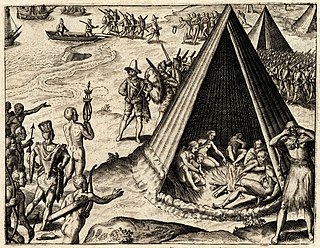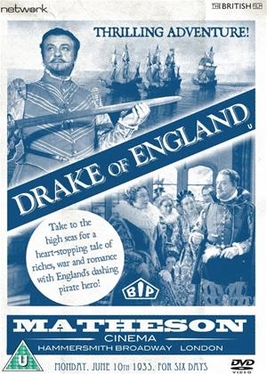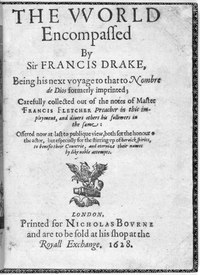
Sir Francis Drake was an English explorer and privateer best known for his circumnavigation of the world in a single expedition between 1577 and 1580. This was the first English circumnavigation, and third circumnavigation overall. He is also known for participating in the early English slaving voyages of his cousin, Sir John Hawkins, and John Lovell. Having started as a simple seaman, in 1588 he was part of the fight against the Spanish Armada as a vice-admiral.

1596 (MDXCVI) was a leap year starting on Monday of the Gregorian calendar and a leap year starting on Thursday of the Julian calendar, the 1596th year of the Common Era (CE) and Anno Domini (AD) designations, the 596th year of the 2nd millennium, the 96th year of the 16th century, and the 7th year of the 1590s decade. As of the start of 1596, the Gregorian calendar was 10 days ahead of the Julian calendar, which remained in localized use until 1923.

New Albion, also known as Nova Albion, was the name of the continental area north of Mexico claimed by Sir Francis Drake for England when he landed on the North American west coast in 1579. This claim became the justification for English charters across America to the Atlantic coast and soon influenced further national expansion projects on the continent. Drake's landing site has been identified as Drake's Cove, which is part of Point Reyes National Seashore.
Thomas Doughty was an English nobleman, soldier, scholar and personal secretary of Christopher Hatton. His association with Francis Drake, on a 1577 voyage to raid Spanish treasure fleets, ended in a shipboard trial for treason and witchcraft, and Doughty's execution.
The Federated Indians of Graton Rancheria, formerly known as the Federated Coast Miwok, is a federally recognized American Indian tribe of Coast Miwok and Southern Pomo Indians. The tribe was officially restored to federal recognition in 2000 by the U.S. government pursuant to the Graton Rancheria Restoration Act.
In 1579, Francis Drake was halfway during his circumnavigation and sailed out in the Pacific, then turned east seeking the Strait of Anián , or for a place to repair his ships.
Guillaume Le Testu, sometimes referred to as Guillaume Le Têtu, was a French privateer, explorer and navigator. He was one of the foremost cartographers of his time and an author of the Dieppe maps. His maps were distinguished by their sophistication and detail; they influenced generations of cartographers, navigators and explorers.
Drake's Venture is a 1980 film depiction of Francis Drake's voyage of circumnavigation. Produced by Westward Television to commemorate the 400th anniversary of the event, it nevertheless focuses on the voyage's most controversial aspect, the execution of the gentleman Thomas Doughty for mutiny. The film has only been aired twice: once in the UK on 28 December 1980, and once in the US, on Masterpiece Theatre, 27 March 1983.

Drake of England is a 1935 British drama film directed by Arthur B. Woods and starring Matheson Lang, Athene Seyler and Jane Baxter. It depicts the life of Francis Drake and the events leading up to the defeat of the Armada in 1588.

A Strange Discovery is an 1899 novel by Charles Romeyn Dake and is a sequel to Edgar Allan Poe's The Narrative of Arthur Gordon Pym of Nantucket which was published in 1838. It follows the experiences of the narrator, an Englishman, during his stay in Bellevue, Illinois, and his encounter with Dirk Peters, Pym's sailor companion in Poe's novel. On his deathbed, Peters relates the missing conclusion to Poe's tale.

Elizabeth Island is the name given to an island off the tip of South America visited by Sir Francis Drake in September 1578, during his circumnavigation of the globe. The island was not seen again and is regarded as a phantom. Various suggestions have been offered as to where Drake landed.
The Cimarrons in Panama were enslaved Africans who had escaped from their Spanish masters and lived together as maroons. In the 1570s, they allied with Francis Drake of England to defeat the Spanish conquest. In Sir Francis Drake Revived (1572), Drake describes the Cimarrons as "a black people which about eighty years past fled from the Spaniards their masters, by reason of their cruelty, and are since grown to a nation, under two kings of their own. The one inhabiteth to the west, the other to the east of the way from Nombre de Dios".
John Oxenham was the first non-Spanish European explorer to cross the Isthmus of Panama in 1575, climbing the coastal cordillera to get to the Pacific Ocean, then referred to by the Spanish as the Mar del Sur.
Captain John Marchant served under Sir Francis Drake from 1585 to 1596, thus participating in some of the most important seafaring expeditions and naval encounters of the day. He lost his life near Nombre de Dios, Panama, a few weeks before Drake's own death.
Sir Francis Drake, 1st Baronet was an English politician who sat in the House of Commons in two parliaments between 1625 and 1629.

Francis Fletcher was a priest of the Church of England who accompanied Sir Francis Drake on his circumnavigation of the world from 1577 to 1580 and kept a written account of it.

Drake's Assault on Panama also known as the Defence of Panama was a military event that took place in January 1596 during the Anglo–Spanish War. An English expedition under the command of Francis Drake and Thomas Baskerville attacked the Spanish Main via Nombre de Dios in order to cross the isthmus of Panama. Ravaged with dysentery and other diseases the English were repelled and defeated. Drake would die of the former and the expedition was forced to retreat back to England all the while harassed by the Spanish.

Francis Drake's circumnavigation, also known as Drake's Raiding Expedition, was an important historical maritime event that took place between 15 December 1577 and 26 September 1580. The expedition was authorised by Queen Elizabeth I and consisted of five ships led by Francis Drake. Termed a 'voyage of discovery', it was in effect an ambitious covert raiding voyage and the start of England's challenge to the global domination of Spain and Portugal.

On 15 November 1577, Francis Drake began a circumnavigation which would last for 1046 days. Before this journey, only a single expedition had completed a circumnavigation, one pioneered by Ferdinand Magellan. On Drake's voyage, Drake was the first Englishman to navigate out of the south Atlantic Ocean and during the journey, he established the first overseas possession claims executed during the reign of Queen Elizabeth I. At its completion, this was the longest voyage humans had made to date.

Francis Drake's expedition of 1572–1573 was an uncommissioned profiteering voyage by Sir Francis Drake in the western and southern quarters of the Caribbean Sea.










